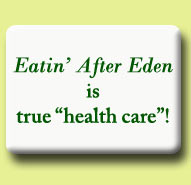CAGED, FREE RANGE, AND PASTURED HENS' EGGS
What difference does it make?
"Amazing results!" the Mother Earth News concluded with the completion of its 2007 egg testing project. Comparing the nutritional output of 14 flocks of hens' across the country to official U.S. Department of Agriculture (USDA) nutrient data for commercial eggs, the pastured (or housed in predator-proof, moveable pens frequently rotated to provide ideal access to fresh pastures) hens' eggs from the former group may contain:
- 2/3 more vitamin A retinol
- 2 times more omega-3 fatty acids
- 3 times more vitamin E complex (not the fractionated isolates of most supplements)
- 7 times more beta carotene (Vitamin A precursor)
- 1/3 less cholesterol
- 1/4 less saturated fat
The United States Department of Agriculture (USDA) now reports that today's eggs have "64% more Vitamin D[3, the best kind] than in 2002," upon its conducting its last such study. In fact, one egg contains almost a day's requirement of this vital vitamin. (It also reports that 2011 eggs have 14% less cholesterol on average than 2002 eggs.) The Creator's small packages of extra quality nutrition contain not only the important fat soluble vitamins A, D, E, and K, but the good fats necessary for their absorption. Actually, the comprehensive slate of nutrients in eggs is an improvement over most fractionated, synthetic multivitamins.
Mother Earth News adds:
We think these dramatically differing nutrient levels are most likely the result of the different diets of birds that produce these two types of eggs. True free-range birds eat a chicken's natural diet—all kinds of seeds, green plants, insects and worms, usually along with grain or laying mash. Factory farm birds never even see the outdoors, let alone get to forage for their natural diet. Instead they are fed the cheapest possible mixture of corn, soy and/or cottonseed meals, with all kinds of additives.1
Six other similar studies are cited at Mother Earth News website, as well as the summary of the nutrients found in the 14 participating flocks as reported by an accredited lab in Portland, OR.
A word of caution is in order here: we were excited to find local pastured hens' eggs at our community market since we find it difficult to eat tasteless supermarket eggs with anemic appearing, pale yellow yolks owing to a diet of soy beans and corn, even if organic. However, there is probably no way to know if these hens really are fed as claimed. It is doubtful layers can produce on grass, bugs, and worms alone as first claimed. Talking further with the seller, we discovered that the chickens actually were also receiving "grains, some organic, some not," since organic grains are expensive and sometimes hard to find for local growers, meaning the hens may actually be feeding on GMO foods as well. Not a good deal at any price.
Eatin' After Eden has a full chapter about eggs, God's "gold standard." Concerning healthy preparation of this marvelous food, suffice it to say here, if there is no yolk left on the plate, you probably are cooking them too long.
- Long, C. and Alterman, T, Mother Earth News, Oct/Nov 2007 http://www.motherearthnews.com/Real-Food/2007-10-01/Tests-Reveal-Healthier-Eggs.aspx#ixzz1MOdyd32F.




